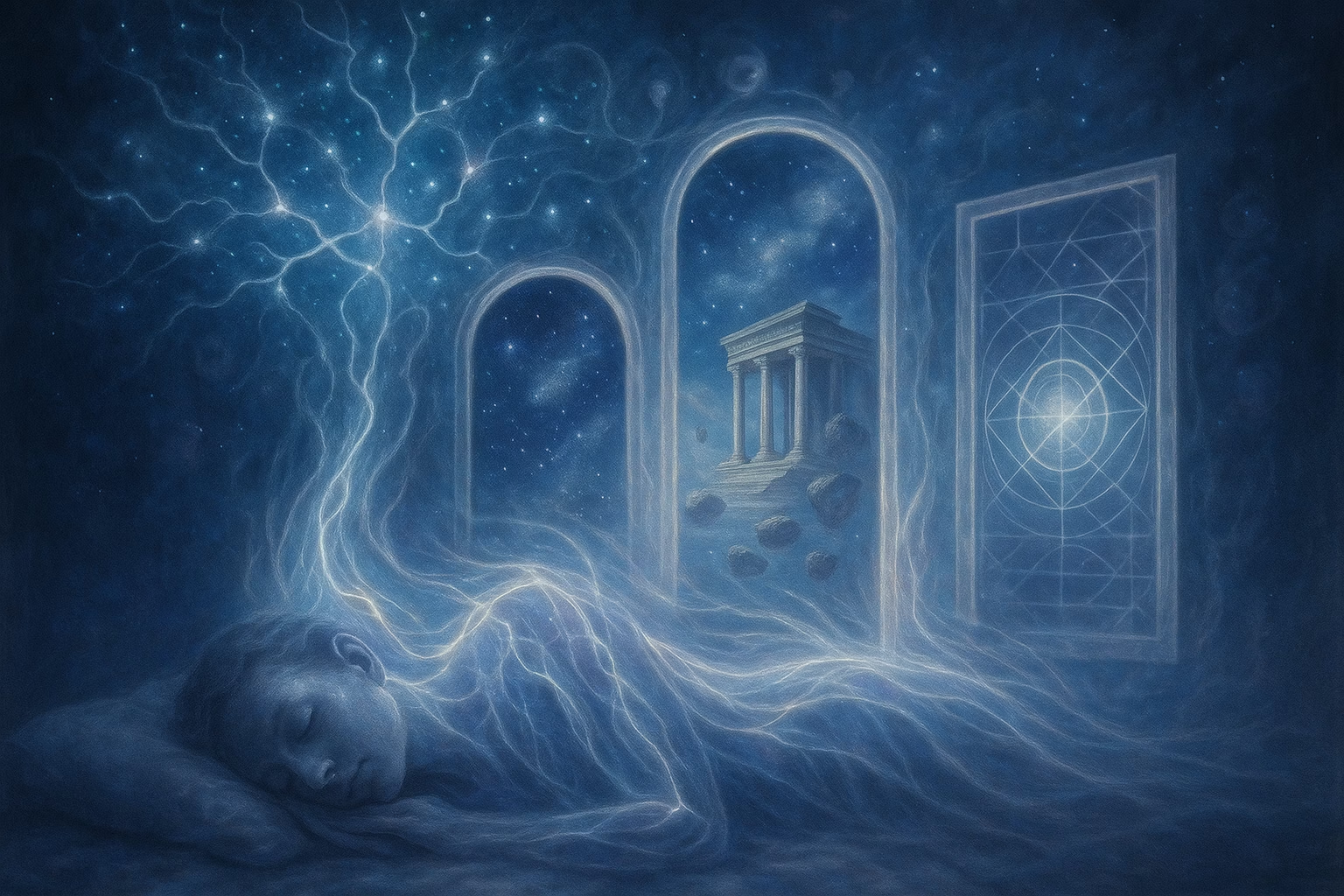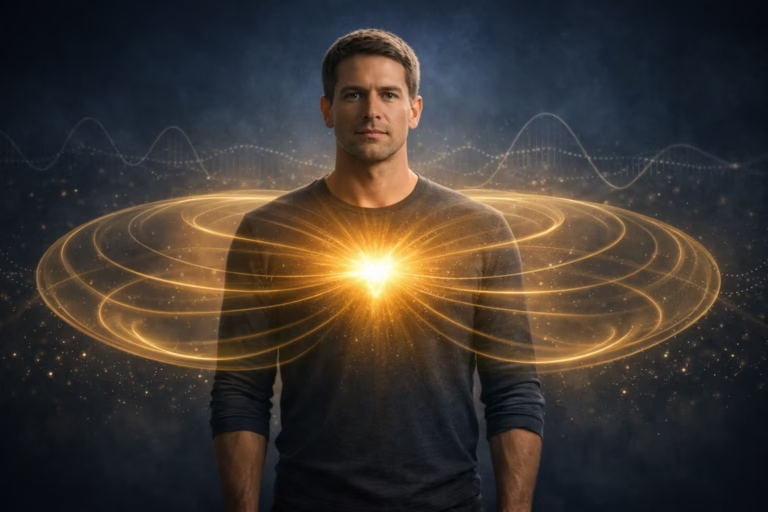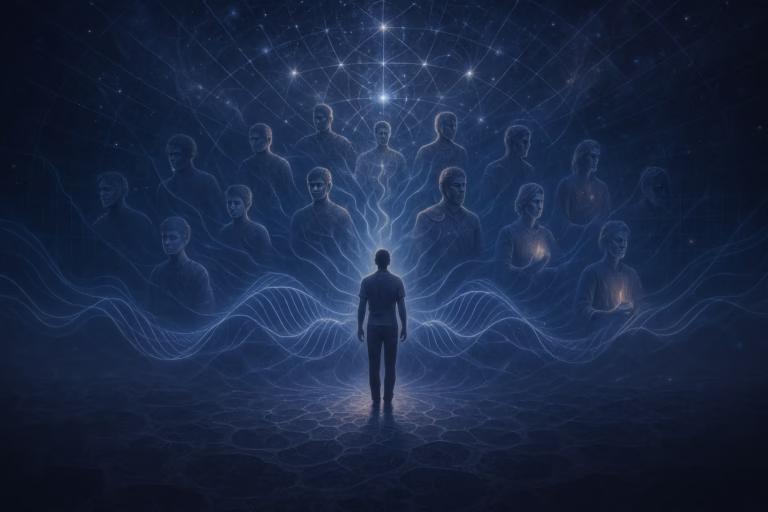PODCAST: Dreams as Doorways
Introduction: The Unfolding Map of the Mind at Night
The human experience is universally punctuated by moments of profound, disorienting strangeness that occur not in waking life, but in the depths of slumber. A dream so vivid and illogical—perhaps of flying effortlessly over a familiar city or having a conversation with a deceased loved one—can feel more real than the reality it briefly displaces.1 This feeling of entering a “simultaneous reality” where the tangible world is momentarily secondary has captivated human imagination for millennia.2 It leads to a fundamental question: are these nocturnal dramas merely the random firings of a resting brain, a meaningless byproduct of biological maintenance, or are they, as ancient traditions have long maintained, a profound gateway? Could dreams serve as a doorway to alternate realities, a conduit for hidden knowledge, or a bridge to higher states of awareness?
This report embarks on a journey to explore this very question, navigating a path that begins in the empirical landscapes of modern neuroscience and psychology. From there, it ventures into the puzzling realm of shared human experience before crossing the bridge to the timeless wisdom of ancient spiritual traditions. Finally, it arrives at the speculative frontiers of quantum mechanics and multiverse theory, where the boundaries between science and philosophy blur. The aim is to bridge these disparate worlds without sacrificing intellectual rigor, asking not only what these varied perspectives can tell us about dreams, but what they can teach us about the very nature of reality itself.
Section I: The Scientific Foundation: The Mind’s Night Shift
To understand the full scope of dreaming, it is essential to first ground the discussion in the current findings of neuroscience and psychology. Far from being a state of mental inactivity, the sleeping brain is a complex and highly active organ. Recent advancements in neuroimaging and electrophysiological techniques have provided a window into this dynamic world, revealing that mental activity during sleep shares similar neural bases with wakefulness.3
The Brain on Dream-Mode
Dreaming is not a passive mental experience but is actively promoted by significant brain activation.3 During sleep, the brain enters a unique state characterized by a reduction in low-frequency brain waves and an increase in rapid-frequency waves, allowing for the vivid, complex narratives that constitute dreams.3 Early research on patients with brain lesions identified two key networks engaged in this oneiric process. An anterior system, which includes the ventromedial prefrontal cortex, is crucial for mental representation and, when damaged, can lead to dream cessation.3 A posterior network, encompassing the temporo-parietal junction, is responsible for visual imagery and other features of the dream experience.3 The brain’s ability to create and navigate these complex, internally generated worlds while detached from external sensory input is a central puzzle that neuroscientists are actively working to unravel.4
Memory and Narrative Construction
One of the most well-established theories in modern dream research is the “continuity hypothesis,” which posits that the thoughts, concerns, and emotionally intense events from our waking life continue and are reflected in our dreams.3 This is demonstrated by specific, observed phenomena. The “day-residue effect” describes the incorporation of recent memories from the previous one to two days into a dream.3 The “dream-lag effect,” on the other hand, refers to the appearance of life events that occurred five to seven days prior, particularly in Rapid-Eye Movement (REM) sleep.3 This phenomenon has led some researchers to hypothesize that dreaming may be a crucial part of memory processing, representing the gradual transfer of new memory representations from the hippocampus to the neocortical circuits, thus integrating them into older representations.3
This process of “offline memory consolidation” suggests that dreams are not arbitrary but actively work to stabilize and reorganize newly formed memory traces into more permanent, long-term storage.6 However, this consolidation is not a simple replay of events. The mind purposefully fragments memories to extract important emotional information and create novel stories or connections that have never been experienced before.7 This accounts for the bizarre, disjointed nature of many dreams, where a familiar place or person might appear in a new, illogical context.8
This sophisticated memory reorganization makes the phenomenon of “dream amnesia” all the more puzzling. Most dreams are forgotten rapidly upon awakening, a fact that is not fully explained by neuroscientific models, especially given that the limbic circuits responsible for memory processes are highly active during REM sleep.8 While some theories, such as Hobson’s AIM model, point to the deactivation of the dorsolateral prefrontal cortex as a factor, others, like psychodynamic models, suggest it is a form of active repression.8 Regardless of the exact mechanism, this paradox highlights the unique and fragile nature of the dream state.
The Lucid Awakening: A State of Paradox
Lucid dreaming—the experience of becoming aware that one is dreaming while still in the dream state—is a fascinating subject that bridges the gap between passive dreaming and conscious control.9 The neurology of this phenomenon is distinctive. During lucid dreaming, brain areas that are typically hypoactive during REM sleep, such as the dorsolateral prefrontal cortex and other frontal regions responsible for logical thinking and self-awareness, become engaged.9 EEG studies show that this is accompanied by the appearance of gamma waves (30–100 Hz), which are typical of wakefulness, indicating a partial awakening of consciousness.10
While this state is often celebrated as a path to enhanced self-awareness, a more nuanced view is emerging in the neuroscience community. Some research suggests that this “unnatural” state, where the brain operates in two modes simultaneously, may come at a cost.10 It can disrupt the brain’s natural sleep processes, which are crucial for rest and neural connection restoration, potentially leading to chronic exhaustion and neurotransmitter depletion.10 The prefrontal cortex’s attempts to control the dream’s emotional content may interfere with the natural, unconscious processing of stress and trauma by the amygdala and hippocampus, leading to an accumulation of emotional tension over time.10
The very practice that is often seen as a doorway to expanded consciousness may, in fact, be a forced opening that bypasses the brain’s natural functions. This presents a powerful contradiction, suggesting that while the experience may be profound, it might also disrupt the delicate biological balance that is essential for both mental and emotional health.10 The following table, summarizing the key neurological differences between states of consciousness, illustrates the unique and paradoxical nature of lucid dreaming.
Table 1: Brain Activity in States of Consciousness
State of Consciousness | Brain Wave Activity | Active Cortical Regions | Function / Experience |
Normal REM Sleep | Theta (4-8 Hz) predominates, with some Beta waves.10 | Limbic system (amygdala, hippocampus), ventromedial prefrontal cortex, posterior parietal area.3 | Emotional memory integration; processing of daily experiences.8 |
Lucid Dreaming | Gamma (30-100 Hz) waves appear, with intensifying Alpha (8-12 Hz) and Beta (12-30 Hz) waves.10 | Dorsolateral prefrontal cortex, bilateral frontopolar prefrontal cortex, precuneus, inferior parietal lobules, supramarginal gyrus.9 | Self-awareness, logical thinking, voluntary control.10 |
Wakefulness | Beta (12-30 Hz) waves are dominant.10 | Widespread cortical and subcortical activity, including full engagement of the prefrontal cortex and monoaminergic systems.8 | Full consciousness, attention, voluntary control, episodic memory.8 |
Section II: The Woven Fabric of Reality: Shared Dreams and Collective Consciousness
If dreams are a personal and private experience, then the phenomenon of shared dreams presents a fundamental challenge to that assumption. Reports of two or more people having the same dream, particularly those with identical or strikingly similar details, suggest that dreaming might not be confined to the individual mind.11
The Enigma of Parallel Experience
Mainstream science and parapsychological experiments have not been able to produce replicable results or provide a good explanation for shared dreams.11 However, there are “literally thousands of well-documented accounts” of this phenomenon.11 The most compelling reports come from individuals in close relationships, such as spouses, twins, or family members, and from therapist-client interactions where a trained professional can verify the account.11 Less common but still reported are cases of complete strangers who discover they have shared a dream when they meet and recognize each other from the experience.11
The consistency of these reports lends them a certain credibility. Often, the discovery occurs spontaneously, with one person beginning to describe a dream only for the other to jump in and finish the story.11 The fact that the recalled details are not always perfectly identical, with minor variations in content and timing, paradoxically increases the confidence in the reports, as this would be expected given the individual differences in memory and mood.11
Beyond the Individual Brain: The Family Unconscious
One proposed explanation for shared dreams comes from the field of parapsychology, which introduces the concept of a “family unconscious”.13 This theory suggests that due to powerful emotions and shared histories, deeply interconnected individuals are part of a “shifting, interconnected field of energy that does not obey the conventional rules of space and time in the waking state”.13 In the dream state, the psychological “boundaries” between individuals change significantly, allowing for this telepathic communication or shared emotional field to become accessible.13
This concept reframes shared dreams not as a random glitch in consciousness but as a systematic and observable phenomenon that occurs among those with a strong emotional bond.13 It suggests that the doorway to a shared reality may not be an external portal, but an inner one that is activated and made accessible by the strength of an emotional connection. The experience of shared dreams, therefore, points to the possibility that at a deeper level of consciousness, the human mind is not a series of isolated islands, but a continent of interconnected experiences.
Section III: The Ancient Practice: Dreams as Sacred Pathways
Long before the advent of neuroscience, cultures around the globe viewed dreams not as an incidental biological process but as a primary means of connecting with a reality beyond the material world. These ancient traditions cultivated specific, intentional practices to navigate the dreamscape, seeking knowledge, healing, and spiritual communion.
Shamanic Journeying: Intentional Travel
Shamanic practice, considered one of the oldest spiritual practices known to humanity, is based on the belief that the waking world is a “very small part of all possible reality”.14 Shamanic journeying is an intentional form of dreamwork that is distinct from spontaneous dreaming. It involves using a “sonic driver,” such as a drum or rattle, to enter an altered state and consciously travel to “other worlds” to interact with spirits or teachers for a specific purpose.14 While a journey may involve conscious imagination, the experiences encountered are considered to be real and not “made up” by the mind.15 The purpose is to bring back information and help from these other realms to address problems in the physical world, which speaks to a belief in a deeply interconnected, multidimensional reality.14
Aboriginal Dreamtime: The Ever-Present Past
The Aboriginal concept of “Dreaming” is perhaps the most profound example of dreams as a foundational pillar of reality. Contrary to a Western interpretation of “Dreamtime” as a period in the distant past, Aboriginal philosophy understands the Dreaming as a continuous, timeless reality that is “there with them, it is not a long way away”.16 It is a beginning that never ended, in which the past, present, and future coexist.16 The Dreaming is the living environment that encompasses the land, its features, and all living things.16
According to these beliefs, Ancestral Spirits rose from the earth and seas, created the landscape, and then transformed into its features—rivers, mountains, and sacred sites—where they continue to live on.16 These Dreamings, passed down through stories, art, and ceremony, not only explain the origin of the universe but also provide individuals with their identity and guide their relationship with the land and other people.16
Tibetan Dream Yoga: Waking Up within the Dream
Tibetan dream yoga is a set of tantric teachings with the ultimate goal of “waking up to the clear awareness that is our fundamental nature”.18 In this tradition, lucid dreaming is not the final objective but a tool to train the mind to abide in “clear, empty awareness”.18 The practice spans the full 24-hour cycle, with daytime exercises designed to train the mind to recognize the dreamlike nature of waking reality.18 By habitually asking “Is this a dream?” throughout the day, the practitioner trains their mind to perform the same query during sleep, leading to lucidity.18 The ultimate aim is to use the freedom of the dream state to transform or remove mental and identity boundaries, and to remain in a state of awareness during deep sleep and even the death process.18
Greek Temple Incubation: Healing Through Divine Dialogue
In ancient Greece, dreams were considered a vital form of communication between gods and humans.20 The practice of “incubation,” or temple sleep, was a form of “dream-psychotherapy” where ailing individuals would sleep in sanctuaries dedicated to the god of medicine, Asclepius.20 The patient would perform rites and sacrifices before sleeping, in the hope that the god or one of his priests would appear in a dream and provide advice or healing.21 The belief was that dreams offered a direct, divinely guided pathway to health and well-being, demonstrating a practical application for the idea of dreams as a portal to a divine or healing realm.20
Despite their vast differences in geography, culture, and methodology, all these ancient traditions share a core, unifying belief: the waking world is not the only reality, and dreams are a primary means of accessing a deeper, more profound truth. This cross-cultural consensus, spanning millennia, suggests a universal human impulse or experience—an instinctive recognition that consciousness extends beyond the physical confines of the body and that dreams are the most natural way to explore this boundless reality.
Table 2: Ancient Dream Traditions
Tradition | Purpose | Method | View of Reality |
Greek Temple Incubation | To receive divine guidance or healing from a god or priest.20 | Sleeping in a holy precinct after performing rites or sacrifices.21 | Dreams are a means of communication with divine beings.20 |
Shamanic Journeying | To travel to “other realities” to seek help from spirits, teachers, or gods.14 | Entering an altered state using a “sonic driver” like a drumbeat.15 | Waking reality is one of an infinite number of possible realities.14 |
Aboriginal Dreaming | To understand one’s place in society, nature, and history, and to connect with Ancestral Spirits.16 | Transferred through storytelling, songs, art, and ceremony.16 | A timeless, continuous reality linking the past, present, and future.16 |
Tibetan Dream Yoga | To achieve lucidity in dreams and abide in a state of “clear awareness”.18 | Daily and nightly practices, including asking “Is this a dream?” and meditating on the throat chakra.18 | Waking life and dreams are both illusory and dreamlike.18 |
Section IV: The Multiverse of the Mind: Quantum and Consciousness
Modern science, while often skeptical of the spiritual realm, is developing its own theories that provide a compelling framework for understanding the surreal, non-linear nature of dreams in a way that parallels ancient beliefs. The bizarre logic of the dream state, which defies classical physics, finds a strange and intriguing partner in the mind-bending principles of quantum mechanics.
The Fluid Reality of Quantum Dreams
Quantum mechanics, the theory that describes the universe at its most microscopic level, posits that particles can exist in “multiple states simultaneously”—a concept known as superposition.22 This principle offers a powerful metaphor for dreams, where a person can experience multiple realities at once, such as seeing themselves as a child in their old home and an adult in their present job within the same dream.22
Similarly, while classical physics dictates a linear, one-directional flow of time, the dream state operates with a disregard for this rule.22 Dream-time can move backward, forward, or in multiple directions, and a few minutes of sleep can feel like hours of experience.22 This aligns with the quantum view that time is not a rigid sequence but may exist as a “probabilistic field”.22 Other quantum phenomena, such as quantum tunneling (particles bypassing barriers) and entanglement (instantaneous influence across vast distances), can be used to describe the abrupt, illogical transitions and shifts in dreams, such as walking through walls or instantly jumping from one location to another without any logical sequence.22
Table 3: Quantum Concepts in the Dreamscape
Quantum Principle | Dream Phenomenon |
Superposition | Experiencing multiple realities, identities, or timelines at once (e.g., being a child and an adult in the same dream).22 |
Non-linear Time | Time flows backward, forward, or loops, with minutes of sleep feeling like hours.22 |
Quantum Tunneling | Surreal transitions like walking through solid walls or defying gravity.22 |
Entanglement | Abrupt and illogical jumps between places, events, or relationships without any linear progression.22 |
The Multiverse Connection
Building on the fluid reality of quantum mechanics, some modern speculative theories propose that dreams may be more than just a metaphorical parallel to the multiverse.23 They suggest that dreams could be literal glimpses into “alternate realities” or “past lives” of other versions of ourselves in parallel universes.24 This theory offers compelling, if unprovable, explanations for familiar psychological phenomena.24
For example, the strange feeling of déjà vu, where a moment feels inexplicably familiar, could be our consciousness recalling a memory from an alternate life or universe.24 Similarly, the “Mandela Effect”—the phenomenon where large groups of people share a false memory of a historical event—is explained as a “glitch” where our consciousness shifts from one dimension to another, bringing memories from the previous universe with it.24 This idea suggests that our dreams are not simply figments of our imagination but bridges to a vast, interconnected multiverse.24
Dreams as Rehearsal and Restoration
Not all modern theories are so speculative, and some offer more grounded, though still metaphorical, explanations for the nature of dreams. The “threat simulation theory” suggests that dreams serve an evolutionary purpose by acting as “rehearsal stages” for threats we might encounter in the real world.7 This could explain why dreams so often feature negative emotions and ancient dangers, such as being chased by a monster, rather than modern threats like having our credit card defrauded.7 By mentally practicing how to respond to these scenarios in a safe environment, the mind can gain an evolutionary advantage.7
Additionally, dreams are seen as a powerful tool for memory consolidation and creative insight. They purposefully fragment and reorganize memories, creating new links and giving rise to new and novel stories.7 This process, which can lead to powerful “aha” moments and creative breakthroughs, is a testament to the brain’s ability to not just consolidate information, but to generate new ideas from seemingly disparate parts.25
Mirrors of the Soul: A Timeless Metaphor
Finally, all these varied fields—speculative physics, neuroscience, and ancient spiritual traditions—rely on a common thread: the use of metaphor to describe a reality that defies conventional logic.7 The “mirrors of the soul” metaphor, found in traditions from Taoism to Sufism, is particularly resonant.26 This metaphor suggests that dreams, like mirrors, reflect the state of our inner self.26
A Sufi mystic, Abd al-Qadir, explained that the clarity of the reflection depends on the cleanliness of the mirror’s surface, which can be “polished” through spiritual practices like yoga, meditation, and prayer.26 A mind cluttered with “unhelpful thoughts” is like a tarnished mirror, resulting in less luminous dreams.26 This powerful analogy suggests that the richness and clarity of our dream life are a direct reflection of our inner state, and that by working on ourselves, we can open up a clearer and more luminous connection to the deeper truths of existence.26
Conclusion: Cultivating the Portal Within
The human experience of dreaming exists at a profound and perplexing intersection of biological function, psychological processing, and spiritual mystery. Modern neuroscience has illuminated the mind’s night shift, revealing a complex and active brain that meticulously processes memories and emotions, sometimes in a paradoxical state that defies our waking understanding.3 At the same time, thousands of anecdotal reports of shared dreams and centuries of ancient practices affirm the timeless human belief that dreams are not confined to the individual mind, but are a means of accessing a deeper, interconnected reality.11
Whether dreams are portals to a quantum multiverse or merely a powerful internal rehearsal stage for our waking life, their enigmatic nature remains a source of endless fascination. What is clear is that the very act of engaging with them—by cultivating a greater awareness of their content, practicing recall, or even attempting to achieve lucidity—can be a powerful tool for self-discovery and personal growth.2
In the end, the true doorway may not be a mystical, external passage, but the very consciousness that gives rise to the dream itself. The collective human experience of dreams, in all its forms, suggests a potential for a deeper, shared understanding of reality that we can access not by looking out, but by venturing inward. By treating our dreams as a valid and important part of our existence, we are not just exploring the mysteries of the universe, but beginning to understand the most profound mystery of all: the infinite and limitless nature of the human mind.
Works cited
- Dreams are alternate universes/ worlds? – Reddit, accessed August 22, 2025, https://www.reddit.com/r/Dreams/comments/htw8z3/dreams_are_alternate_universes_worlds/
- Mutual Dreaming – Futuress, accessed August 22, 2025, https://futuress.org/stories/mutual-dreaming-with-your-kin/
- Investigation on Neurobiological Mechanisms of Dreaming in the …, accessed August 22, 2025, https://pmc.ncbi.nlm.nih.gov/articles/PMC7916906/
- Dreaming and Offline Memory Processing – PMC, accessed August 22, 2025, https://pmc.ncbi.nlm.nih.gov/articles/PMC3557787/
- The science of dreams | Knowable Magazine, accessed August 22, 2025, https://knowablemagazine.org/content/article/mind/2022/science-dreams
- pmc.ncbi.nlm.nih.gov, accessed August 22, 2025, https://pmc.ncbi.nlm.nih.gov/articles/PMC4704085/#:~:text=Converging%20evidence%20suggests%20that%20dreaming,form%20of%20long%2Dterm%20storage.
- Your Terrifying Dreams Could Be Rehearsal for Real Life – Nautilus, accessed August 22, 2025, https://nautil.us/your-terrifying-dreams-could-be-rehearsal-for-real-life-236031/
- Dreaming and the brain: from phenomenology to neurophysiology – PMC – PubMed Central, accessed August 22, 2025, https://pmc.ncbi.nlm.nih.gov/articles/PMC2814941/
- en.wikipedia.org, accessed August 22, 2025, https://en.wikipedia.org/wiki/Lucid_dream#:~:text=Mutz%20and%20Javadi%20found%20that,lobules%2C%20and%20the%20supramarginal%20gyrus.
- Lucid Dreaming’s Impact On Brain And Emotion – Lone Star Neurology, accessed August 22, 2025, https://lonestarneurology.net/others/how-lucid-dreaming-affects-brain-function-and-emotional-health/
- Can Two People Have the Same Dream? | Psychology Today, accessed August 22, 2025, https://www.psychologytoday.com/us/blog/dream-catcher/201606/can-two-people-have-the-same-dream
- Dream telepathy – Wikipedia, accessed August 22, 2025, https://en.wikipedia.org/wiki/Dream_telepathy
- Psi, the Shared Dreamscape and the Family Unconscious | The …, accessed August 22, 2025, https://dreamnetworkjournal.com/bcpov6zfamil/psi-the-shared-dreamscape-and-the-family-unconscious
- Shamanic dreaming: Dreaming Awake – Manda Scott, accessed August 22, 2025, https://mandascott.co.uk/dreaming-awake/
- Dreaming and Journeying – Compass Dreamwork, accessed August 22, 2025, http://www.compassdreamwork.com/dreaming-journeying/
- Understanding Aboriginal Dreaming – Artlandish Aboriginal Art, accessed August 22, 2025, https://www.aboriginal-art-australia.com/aboriginal-art-library/understanding-aboriginal-dreaming-and-the-dreamtime/
- www.aboriginal-art-australia.com, accessed August 22, 2025, https://www.aboriginal-art-australia.com/aboriginal-art-library/aboriginal-dreamtime/#:~:text=Indigenous%20people%20understand%20the%20Dreamtime,momentous%20actions%20of%20the%20creators.
- How to Practice Dream Yoga | Lion’s Roar, accessed August 22, 2025, https://www.lionsroar.com/is-this-a-dream/
- The Dalai Lama on Dream Yoga – The Wisdom Experience, accessed August 22, 2025, https://wisdomexperience.org/wisdom-article/the-dalai-lama-on-dream-yoga/
- Incubation as a form of psychotherapy in the care of patients in ancient and modern Greece, accessed August 22, 2025, https://pubmed.ncbi.nlm.nih.gov/170636/
- Incubation | religion – Britannica, accessed August 22, 2025, https://www.britannica.com/topic/incubation-religion
- Dream-Time and Consciousness: A Quantum Perspective …, accessed August 22, 2025, https://arunsingha.in/2024/09/16/dream-time-and-consciousness-a-quantum-perspective/
- Dreams and multiverse theory – Reddit, accessed August 22, 2025, https://www.reddit.com/r/Dreams/comments/1kq2tjg/dreams_and_multiverse_theory/
- Dreams, Death, and the Multiverse: A Journey Through the Fourth …, accessed August 22, 2025, https://medium.com/@usepecortez220/dreams-death-and-the-multiverse-a-journey-through-the-fourth-dimension-9092d88f031c
- Why Do We Dream? Understanding Dream Theory – Verywell Mind, accessed August 22, 2025, https://www.verywellmind.com/why-do-we-dream-top-dream-theories-2795931
- The Spiritual Science of Mirrors in Dreamwork | Dream Studies Portal, accessed August 22, 2025, https://dreamstudies.org/spiritual-science-mirrors-dreaming/




